It happens all the time. You do your best to build out a set of campaigns in Google Ads that follow industry best practices and that are aimed at your goals, but you just aren’t seeing the results you’re looking for. So what do you do?
Luckily, there are some pretty common issues that arise to cause poor performance and, for the most part, they can be pretty easily addressed assuming you’re willing to put in a little elbow grease.
Here’s a list of the things you should be looking at to get your performance turned around and make sure you’re hitting the goals you’re out to achieve.
Contents
- Check your conversion tracking setup
- Look into your goal optimization settings
- Adjust your bid strategies
- Evaluate your targeting
- Determine whether or not you have segment inefficiencies
- Assess your copy and landing pages
- Get on a good optimization schedule
How to fix poor-performing Google Ads in 7 steps
Follow these steps to turn your performance around.
1. Check your conversion tracking setup
A foundational aspect of paid media campaigns is their trackability. It’s one of the key factors that sets these campaigns apart from other tactics. But it can also be a very easy mistake to overlook when trying to figure out why performance isn’t where you want it.

Whenever I have a campaign that has started performing poorly, or that has never performed well, I always go back and check on the conversion tracking setup to ensure everything is working well. Only when that’s confirmed do I move on to other potential issues.
✅ Action items
- Confirm your Google Tag is on all pages of your website.
- Confirm your conversion pixels are firing on the right pages or events for all individual conversion actions on your site.
🚨 Want a quick look at where you can make improvements to your Google Ads campaigns? Get an instant audit >> Free Google Ads Performance Grader
2. Look into your goal optimization settings
Just because your conversion actions are firing properly doesn’t mean we’re finished with conversion action setup. Depending on how you have your account set up, you can be either prioritizing or de-prioritizing different conversion events.
Here are three things to look into:
Account default goals
In the conversion manager, each action item is organized into a conversion category. That conversion category is then considered either an account default goal, meaning the conversion actions in that category will be counted in the conversions column, or not.
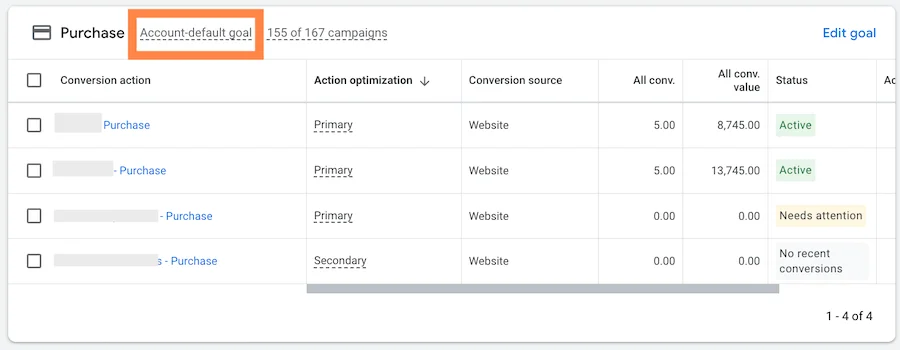

If the conversion actions you’re trying to optimize for are not in an account default goal category, then you may need to make some adjustments. (There are other settings you can use to overcome this that we’ll cover soon.)
Secondary vs. Primary goals
Issues can arise when your conversion action is set to a Secondary goal rather than a Primary one. Primary goals are counted in the conversions column and used as optimization events for Smart Bidding, but Secondary actions are not used as optimization signals and are only counted in the All Conversions column–not Conversions.
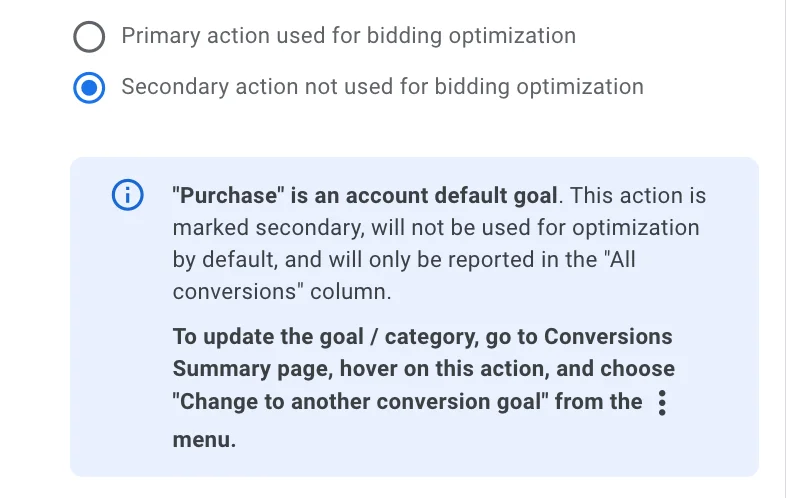

Individual campaign setting goals
At the campaign level, advertisers can opt to use account-level or campaign-level conversions. If your campaigns are set up to focus on conversions that are different from your account-level goals, that could also be causing issues in performance.


✅ Action items
- Confirm all conversion tracking is working properly.
- Ensure all account default goals are set up to your liking.
- Make sure all goals are assigned either Primary or Secondary status as needed.
- Don’t forget to confirm that all campaign-level settings are in line with your goals.
3. Adjust your bid strategies
All of the Google Ads bid strategies are designed to do a very specific thing, so if you’re using the wrong one, it could be causing issues.
For the most part, all of these bid strategies are pretty self-explanatory. Maximize Conversions and Maximize Conversion Value work to get you good results, but sometimes they can be less efficient than those same bid strategies with additional controls like tCPA and tROAS.
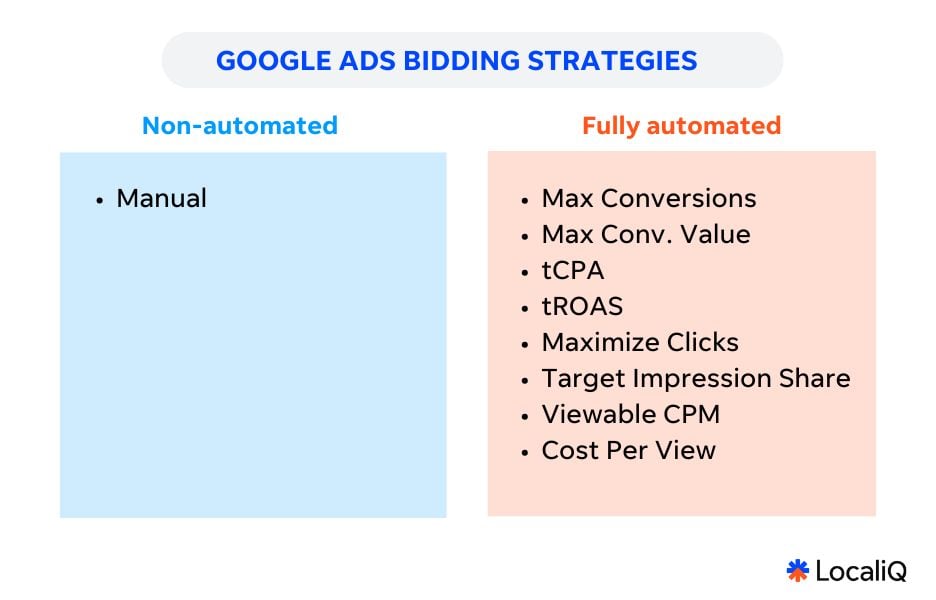

But in addition to picking the right bid strategy, it’s also important to make sure the bid strategy is set up for success. Smart Bidding requires enough success points and wiggle room to see results.
Here are some common problems we see with bid strategies that hinder performance:
Unrealistic goals
While we would all like to have extremely high ROAS or super low CPLs, that doesn’t mean they’re realistic and achievable in the long run. To help keep your goals realistic, start out with targets that are in line with your performance as a business.
If your entire site sees a 300% ROI, then 300% is likely a reasonable ROAS to set. When you leverage unrealistic goals, like 1,000% ROAS on a site with 300% ROI, you’ll stifle the bid strategy, and it will slowly stop serving ads since it likely can’t hit your target.
Limited performance indicators
A common issue I see with bid strategies centers around the volume of conversions being tracked. A general rule of thumb is one conversion per day.


If your account (not campaign, account) isn’t averaging at least 30 conversions in 30 days, then you might not have enough volume to optimize for that action.
Without those positive indicators coming in regularly, Google won’t get enough positive signals that a click leads to a conversion and will, again, slowly stop serving ads.
Restricted budgets
Even if you have realistic goals and enough conversion volume, keeping your budget too low can cause issues. Yes, we know Google always tells you to increase your budget, but this could be a performance killer.
If your target CPL is $100, but your daily budget is only $50, then you’re setting that campaign up to hit only one conversion every couple of days, falling below our regular rule of thumb.
Not adjusting bid strategies with time
Just because a bid strategy works for you for a time, that doesn’t mean it will work forever. You may need to change bid strategies or tweak the settings for that bid strategy over time. These require regular maintenance and adjustment right alongside all the other aspects within your account.
✅ Action items
- Review your bid strategies and ensure they’re the right ones to achieve your goals.
- Be sure the goals for your campaigns are realistic.
- Ensure your campaigns have enough budget for your bid strategy to operate.
- Only use Smart Bidding strategies for conversion actions that have enough volume to support the machine learning cycles.
- Regularly review your bid strategy settings and performance, and don’t be afraid to test and iterate as needed to keep seeing strong results.
💰 How much should you be spending on Google Ads? Get our latest Google Ads Benchmarks to find out.
4. Evaluate your targeting
There are tons of different types of targeting options in Google Ads, and depending on what your goals are, many of them can cause issues with your performance.
Let’s look into a few targeting options to evaluate:
Keyword match types
Even though Google loves them, Broad match terms can reach a very wide range of users. They have the widest reach of all the match types and can end up showing for quite a bit of traffic that isn’t relevant to your business. Broad match isn’t categorically bad, but without oversight, it can get out of hand very quickly.


Performance Max
Performance Max targets users across all networks within the Google Ads ecosystem, and each of those placements has their own set of best practices when it comes to targeting.


Within the Performance Max campaign setup, you have some controls over where you show, but they’re less specific than other campaign types. Search themes are just suggestions, not keywords. Audience signals are just a starting point for targeting, not exclusive targeting settings that Google stays within.


Without full control over those targeting settings, you could see good results from Google’s machine learning, or you could struggle to hit goals as their system gets further from your intended targets.
Optimized targeting
In Display campaigns, there’s a setting that operates similarly to the expansion tactics in Performance Max–Optimized Targeting. The difference is that you can opt out of this within Display campaigns.


Google will warn you that your campaigns might not perform as well, but if the expansion is the reason for the low performance, then you’re likely on the right path.
✅ Action items
- Review your targeting to ensure you’re reaching the right people.
- Review search queries to determine if your match types need to be tightened up.
- Opt out of Optimized Targeting for Display campaigns.
- Test using other campaign types other than Performance Max.
5. Determine whether or not you have segment inefficiencies
Expanding on the idea of targeting inefficiencies, some pockets of performance aren’t necessarily targeting but are still sneaky subsets of targeting that can drive your account to underperform.
Network problems
For Search campaigns, you can opt into the Search Partner Network, which is an expanded network of listings on sites other than Google, but powered by Google Search. These placements can range from totally legit to completely sketchy.


Whenever I have bad performance in a Search campaign, one of the first places I look is at the Search Partner performance. On the campaigns tab, just segment your data by Network, and you’ll see how it’s doing compared to regular Google Search.
If things look bad, you can opt out in your campaign settings.
While we’re here, this brings up another Network issue. By default, Google will opt Search campaigns into the Display Network. Please, please, please, don’t do this. If you want a cross-platform campaign, use Performance Max. Just uncheck this box every time.


Device performance
Another segment you can check on is Device. If you’re alive in 2025, you’re probably more than aware of the differences between being on a mobile device vs. a computer vs. a tablet vs. a television. Those differences can cause performance variance between the device categories.
Unfortunately, Google has kind of buried the Device report in the newly rearranged interface. You can find your accounts’ device performance in the Insights and Reports section, in the When and Where Ads Showed report, then choose the Devices tab. Depending on the other settings for your campaign, you can either opt out of a device category as a whole or you can adjust your bids to be more or less aggressive for a specific device category.


Additional segments to review
Other categories that are good to check include your Ad Scheduling, Location targeting, and Audience segments. These can each be found in different sections of the interface and don’t typically have runaway poor performance, but each could be the key to finding smaller-scale inefficiencies that cause performance to be lower than desired.
✅ Action items
- Keep Search campaigns focused on Search and opt out of the Display network.
- Understand how different device categories, locations, ad schedules, and audience segments are performing in your account and adjust as needed.
6. Assess your copy and landing pages
Google Ads campaigns definitely have lots of technical considerations that go into them to see good performance. The previous sections should highlight that pretty well.
But these campaigns also require you to have a personal marketing touch, which means the content and designs that feed your campaigns need to be compelling and user-friendly.
One problem area can be your ad copy. If your ads aren’t coherent and or action-oriented, you likely won’t see good results. There are tons of resources available that can help you write great ads. Just take advantage.
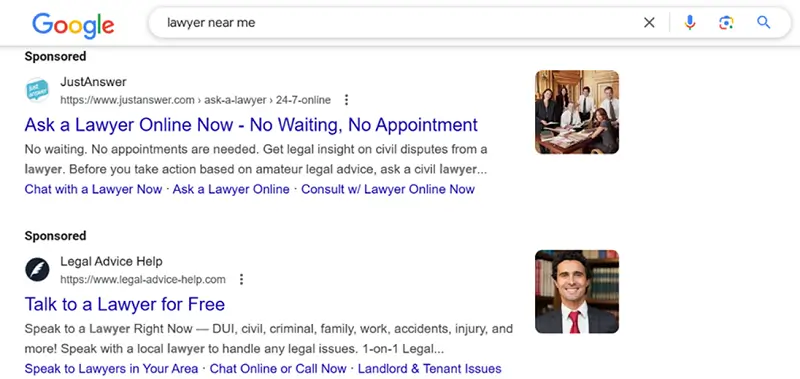

Get Google Ads examples here for inspiration.
The same goes for your landing page. If the landing page is particularly slow, light on details, or is laid out confusingly, you’re likely not going to see the conversions you want from your campaigns. Again, there are so many resources available for you to review to get ideas.
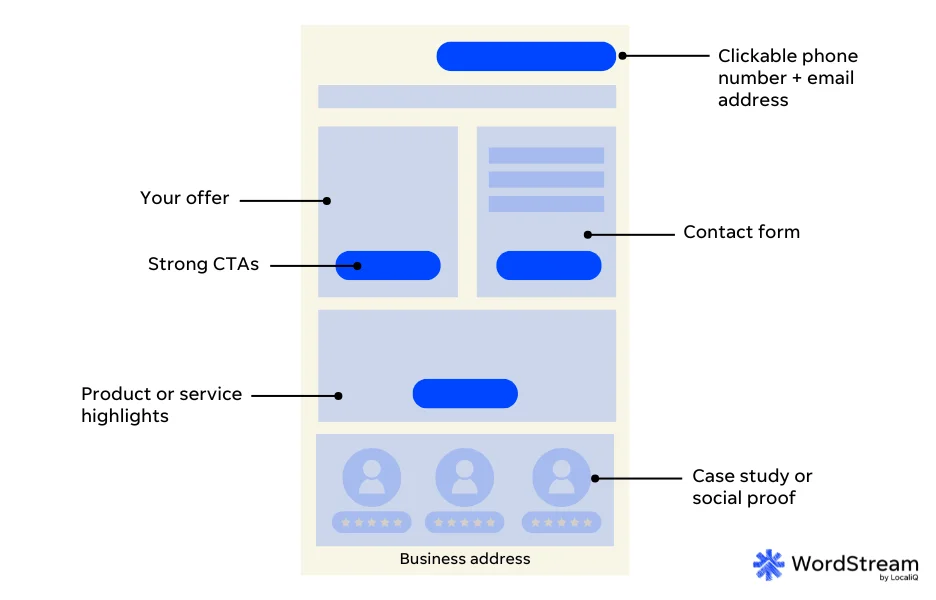

✅ Action items
- Retain the human angle when writing new copy or developing new landing pages.
- Make sure your ad copy is coherent, relevant, compelling, and creates interest.
- Create landing pages that follow industry best practices, have clear calls to action, use relevant supporting information, and limit friction to conversion.
🚀 Want to know what makes a stand-out landing page? Download the guide >> How to Make Great Landing Pages (with Crazy High Conversions)
7. Get on a good optimization schedule
Just because you put in all that time and effort to launch a shiny new campaign strategy doesn’t mean it’s going to perform well forever. These are living, breathing things and need to be regularly maintained to see good results.
Regular optimizations
If you’re not regularly optimizing your account, you’re likely going to see issues. The good news is that the regular cadence of optimizations addresses many of the points in this post, but also, WordStream has a ton of posts that you can review to see all sorts of things you should be doing to your accounts at all times.
Automated optimizations
Although you might think it’s in your best interest, one of the other problems I regularly see with accounts is when optimizations are left to the machines. Despite what they may say, Google doesn’t always know what your goals are with their automated optimizations. Some of them can be good, but without regular human oversight, they can “optimize” your account right into the ground.


The Auto Apply Recommendations within Google Ads are easily turned off by visiting the Recommendations tab, then clicking the Auto-apply icon in the upper right of the screen, then turning off any or all of the automatic updates.
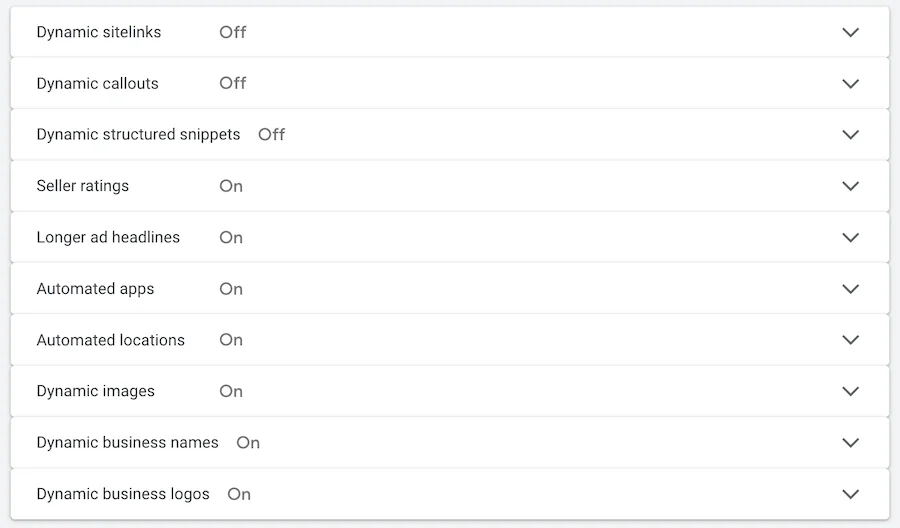

There are also Automated Assets that Google opts every account into that you can remove. These have a few more hidden steps to deactivate, but can be well worth it.
✅ Action items
- Create a regular cadence of tasks to execute on your account and stick to it.
- Don’t let Google make changes on your behalf that you’re not aware of. Opt out of the recommendations you don’t want and keep the ones you’re okay with.
- Do the same for Automatically Applied Assets and make sure all customer-facing messaging is approved by you.
Fix poor-performing Google Ads fast
Low performance in a Google Ads account isn’t a death knell. In almost every scenario, there’s something you can do about it. Hopefully, this rundown has given you ideas of where to look for poor performance influences and what to do about them when you find them. But if you need more help, reach out for a demo to see how we can fix your Google Ads for you fast.









